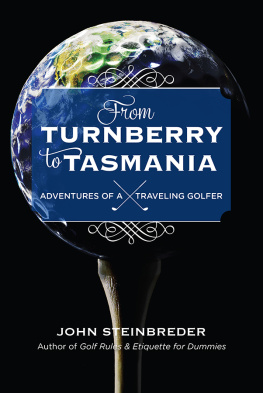From Turnberry to Tasmania
Adventures of a Traveling Golfer
John Steinbreder
TAYLOR TRADE PUBLISHING
Lanham Boulder New York London
Published by Taylor Trade Publishing
An imprint of The Rowman & Littlefield Publishing Group, Inc.
4501 Forbes Boulevard, Suite 200, Lanham, Maryland 20706
www.rowman.com
Unit A, Whitacre Mews, 26-34 Stannary Street, London SE11 4AB, United Kingdom
Distributed by NATIONAL BOOK NETWORK
Copyright 2015 by John Steinbreder
The map in chapter 20 is from Serban Bogdan/Thinkstock. All other maps courtesy of the University of Texas Libraries, The University of Texas at Austin.
All rights reserved . No part of this book may be reproduced in any form or by any electronic or mechanical means, including information storage and retrieval systems, without written permission from the publisher, except by a reviewer who may quote passages in a review.
British Library Cataloguing in Publication Information Available
Library of Congress Cataloging-in-Publication Data Available
ISBN 978-1-58979-994-3 (cloth)
ISBN 978-1-58979-995-0 (electronic)
 The paper used in this publication meets the minimum requirements of American National Standard for Information SciencesPermanence of Paper for Printed Library Materials, ANSI/NISO Z39.48-1992.
The paper used in this publication meets the minimum requirements of American National Standard for Information SciencesPermanence of Paper for Printed Library Materials, ANSI/NISO Z39.48-1992.
Printed in the United States of America
To my mother, Cynthia Means Steinbreder,
who always encouraged me as a writer and endowed me
with a love of reading, traveling and learning.
God be with you until we meet again.
Introduction
Among the most surprising and satisfying attri butes of golf is how well it lends itself to travel, and how it gives practitioners the opportunity to play courses all over the planet, see the world, and experience different people, places, and things. It is a sport, to be sure, and serious good fun. But golf is also a vehicle of discovery.
Start with the courses on which the game is played. Each track is different in terms of design, locale, and look and can be regarded as individual pieces of art. The best ones have ways of truly testing the playing skills of golfers as they also present them with the opportunities to hit shots that are both pleasing and exciting, whether off elevated tees to ample landing areas or from closely cropped fairways to well-bunkered greens. Great courses demand that players think their way through their rounds and manage their games. And one cannot underestimate the joy that so many traveling golfers get from experiencing the work of different designers and then analyzing their layouts after rounds, the way that art students might discuss the paintings they just viewed in a museum.
That sense of exploration and enlightenment gets particularly strong when a golfer tees it up on a historic course and considers the architect who laid out and built the track as well as the significant professional and amateur competitions it has hosted over the years. Thats one of the things I fancy about a place such as the Lancashire coast in northwest England, and the opportunity to play hallowed retreats like Royal Liverpool, Royal Lytham & St. Annes, and Royal Birkdale, which have notable tournament histories, thanks to hosting numerous Open Championships, and also possess colorful and intriguing pasts as members clubs. At the same time, I find there is plenty to learn from and like about newer courses, such as Bandon Dunes and Old Macdonald in Oregon and Sand Hills in central Nebraska, for they offer keen insights on modern architecture and how designers today work with the land.
Then, there is the innate beauty of the vast majority of the tracks I have visited in my travels. As a rule, they are situated on attractive parcels of land. Along coasts, among piney woods, in nature preserves, and atop mountains. Just as appealing are the ways that golf courses can give a strong sense of the regions to which a player has traveled. Strolls around the Lost Farm course at Barnbougle in Tasmania that include encounters with tawny wallabies and blue-tongued lizards give players an unmistakable feel for the fauna of that faraway place, while the links of St. Andrews induce an instant and indelible sense of being on the Scottish coast, especially when the wind is blowing salty air across gnarly sand dunes and the steel-gray waters of the North Sea are roiling. And those sensations are only enhanced when those courses are walked, for walking allows you not only to see a place in a peaceful and unhurried way but also to absorb its many elements.
Some spots are so exotic and full of character that the education and enjoyment never stops, whether you are on the course or not. During one trip to Morocco, for example, I teed it up on one of King Hassan IIs courses in the Imperial City of Meknes, a track laid out entirely inside the grounds of the royal palace. Afterward, I drove to the ancient Roman city of Volubilis, where I spent a couple of hours ambling down the stone streets of that historic site. Later that night, I dined on savory roasted lamb and sipped fragrant mint tea at a food stall in the Jemaa el Fna, or Place of the Dead, next to the ancient souk in the heart of Marrakesh, still wearing my FootJoys and what turned out to be a daylong grin.
To be sure, treks to places previously unknown are a wanderers delight. But golf as it exists for the traveling player rarely feels so foreign as to cause discomfort. For no matter how far afield the locations of the courses may be, no matter how wild and weird the settings, it is not hard to feel at home given the universality of the sport. Consider how many elements of a golf course and club are constants no matter where they are situated. Whether a welcoming pro shop or a proper locker room, a verdant putting green, or a spacious practice range. The first glimpses of the fairways and greens, the tees and bunkers of a golf course can make a player feel right at home, and so can a convivial 19th hole, where postround drinks are shared with newfound friends.
I also find that golf has a way of encouraging terrific camaraderie no matter what the locale. It enables people of all ages, abilities, and backgrounds to meld so easily. I have been in foursomes when the most common language is French or German, or one time even Arabic. Yet the group invariably came together as if it was composed of long lost friends, and no one was a stranger when our 18 holes were done.
The idea behind this book is to tell some of my stories from nearly two decades of traveling with my clubs and take readers to places they have never been as I also demonstrate how strong the connection between golf and travel isand how it can lead them to embark on some very satisfying trips to all parts of the world.
The royal and ancient game has allowed me to wander like a modern-day Burton or Spekefrom Turnberry to Tasmania and back againand to experience not only the great golf courses but also the locales themselves, in all their splendor and beauty. It has been a terrific ride, and I hope that you as readers will enjoy it as well.
The Old World
St. Andrews
At Home in the Home of Golf
As if the chance to play the Old Course isnt inducement enough to visit St. Andrews, as if the opportunity to tee it up on the other fine tracks on the links of the Auld Grey Toon isnt a good reason to fly right over, heres one more motive: theres no place on earth with so much good golf in such close proximity.
To be sure, everyone knows about the Old. If Scotland is golfs Holy Land, then the Old Course in St. Andrews is its Jerusalem. After all, it is where the royal and ancient game has been played since the fifteenth century, and where King James II banned the sport in 1457 because he believed it was distracting his soldiers from their archery practice. In addition, the Old has hosted twenty-nine British Open Championships as of this writing, far more than any other course. And most duffers are aware that there are other superb places to play on the links of St. Andrews. Like the New Course, a raw and rugged track that is actually more than a century old, and the Jubilee and Eden courses. But how many people truly comprehend all the amazing golfing riches that exist in and around this outpost in the Kingdom of Fife, courses of enormous strength and character that were formed centuries ago by some of the oldest golfing associations on earth?
Next page










 The paper used in this publication meets the minimum requirements of American National Standard for Information SciencesPermanence of Paper for Printed Library Materials, ANSI/NISO Z39.48-1992.
The paper used in this publication meets the minimum requirements of American National Standard for Information SciencesPermanence of Paper for Printed Library Materials, ANSI/NISO Z39.48-1992.